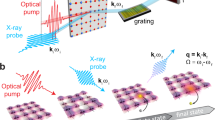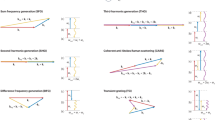Abstract
The emission of light from charged particles underlies a wealth of scientific phenomena and technological applications. Classical theory determines the emitted photon energy by assuming an undeflected charged particle trajectory. In 1940, Ginzburg pointed out that this assumption breaks down in quantum electrodynamics, resulting in shifts—known as quantum recoil—in outgoing photon energies from their classically predicted values. Since then, quantum recoil in free-electron light-emission processes, including Cherenkov radiation and Smith–Purcell radiation, has been well-studied in theory, but an experimental demonstration has remained elusive. Here we present an experimental demonstration of quantum recoil, showing that this quantum electrodynamical effect is not only observable at room temperature but also robust in the presence of other electron-scattering mechanisms. By scattering free electrons off the periodic two-dimensional atomic sheets of van der Waals materials in a tabletop platform, we show that the X-ray photon energy is accurately predicted only by quantum recoil theory. We show that quantum recoil can be enormous, to the point that a classically predicted X-ray photon is emitted as an extremely low-energy photon. We envisage quantum recoil as a means of precision control over outgoing photon and electron spectra, and show that quantum recoil can be tailored through a host of parameters: the electron energy, the atomic composition and the tilt angle of the van der Waals material. Our results pave the way to tabletop, room-temperature platforms for harnessing and investigating quantum electrodynamical effects in electron–photon interactions.
This is a preview of subscription content, access via your institution
Access options
Access Nature and 54 other Nature Portfolio journals
Get Nature+, our best-value online-access subscription
$29.99 / 30 days
cancel any time
Subscribe to this journal
Receive 12 print issues and online access
$209.00 per year
only $17.42 per issue
Buy this article
- Purchase on Springer Link
- Instant access to full article PDF
Prices may be subject to local taxes which are calculated during checkout



Similar content being viewed by others
Data availability
The data represented in Figs. 1–3 are available as Supplementary Information files. All other data that support the plots within this paper and other findings of this study are available from the corresponding author upon reasonable request. Source data are provided with this paper.
Code availability
All code that support the plots within this paper are available from the corresponding authors upon reasonable request.
References
Frank, I. M. Doppler effect in a refractive medium. Bull. Russ. Acad. Sci. Phys. 6, 2 (1942).
Smith, S. J. & Purcell, E. M. Visible light from localized surface charges moving across a grating. Phys. Rev. 92, 1069 (1953).
Cherenkov, P. A. Visible emission of clean liquids by action of gamma radiation. Dokl. Akad. Nauk SSSR 2, 451–454 (1934).
Tamm, I. E. & Frank, I. M. Coherent visible radiation of fast electrons in a medium. Dokl. Akad. Nauk SSSR 14, 107–112 (1937).
Gover, A. et al. Superradiant and stimulated-superradiant emission of bunched electron beams. Rev. Mod. Phys. 91, 035003 (2019).
Polman, A., Kociak, M. & García de Abajo, F. J. Electron-beam spectroscopy for nanophotonics. Nat. Mater. 18, 1158–1171 (2019).
Ryabov, A. & Baum, P. Electron microscopy of electromagnetic waveforms. Science 353, 374–377 (2016).
Adamo, G. et al. Light well: a tunable free-electron light source on a chip. Phys. Rev. Lett. 103, 113901 (2009).
So, J. K. et al. Cerenkov radiation in metallic metamaterials. Appl. Phys. Lett. 97, 151107 (2010).
Yang, Y. et al. Maximal spontaneous photon emission and energy loss from free electrons. Nat. Phys. 14, 894–899 (2018).
Rivera, N., Wong, L. J., Joannopoulos, J. D., Soljačić, M. & Kaminer, I. Light emission based on nanophotonic vacuum forces. Nat. Phys. 15, 1284–1289 (2019).
Yu, Y. et al. Transition radiation in photonic topological crystals: quasiresonant excitation of robust edge states by a moving charge. Phys. Rev. Lett. 123, 057402 (2019).
Lin, X. et al. Controlling Cherenkov angles with resonance transition radiation. Nat. Phys. 14, 816–821 (2018).
Lin, X. et al. A Brewster route to Cherenkov detectors. Nat. Commun. 2, 5554 (2021).
Remez, R. et al. Observing the quantum wave nature of free electrons through spontaneous emission. Phys. Rev. Lett. 123, 060401 (2019).
Nussupbekov, A. et al. Enhanced photon emission from free electron excitation of a nanowell. APL Photonics 6, 096101 (2021).
Wang, Z., Yao, K., Chen, M., Chen, H. & Liu, Y. Manipulating Smith–Purcell emission with Babinet metasurfaces. Phys. Rev. Lett. 117, 157401 (2016).
Haeusler, U., Seidling, M., Yousefi, P. & Hommelhoff, P. Boosting the efficiency of Smith–Purcell radiators using nanophotonic inverse design. ACS Photonics 9, 664–671 (2022).
Roques-Carmes, C. et al. Free-electron–light interactions in nanophotonics. Preprint at https://arxiv.org/abs/2208.02368 (2022).
Ye, Y. et al. Deep-ultraviolet Smith–Purcell radiation. Optica 6, 592–597 (2019).
Shentcis, M. et al. Tunable free-electron X-ray radiation from van der Waals materials. Nat. Photonics 14, 686–692 (2020).
Huang, S. et al. Enhanced versatility of table-top X-rays from van der Waals structures. Adv. Sci. 9, 2105401 (2022).
Breuer, J. & Hommelhoff, P. Laser-based acceleration of nonrelativistic electrons at a dielectric structure. Phys. Rev. Lett. 111, 134803 (2013).
Shim, H., Fan, L., Johnson, S. G. & Miller, O. D. Fundamental limits to near-field optical response over any bandwidth. Phys. Rev. X 9, 011043 (2019).
Ginzburg, V. L. Quantum theory of radiation of an electron uniformly moving in medium. Zh. Eksp. Teor. Fiz. 10, 589–600 (1940).
Neitz, N. & Di Piazza, A. Stochasticity effects in quantum radiation reaction. Phys. Rev. Lett. 111, 054802 (2013).
Debus, A., Steiniger, K., Kling, P., Carmesin, C. M. & Sauerbrey, R. Realizing quantum free-electron lasers: a critical analysis of experimental challenges and theoretical limits. Phys. Scr. 94, 074001 (2019).
Bonifacio, R., Piovella, N., Robb, G. R. M. & Schiavi, A. Quantum regime of free electron lasers starting from noise. Phys. Rev. Spec. Top. Accel. Beams 9, 090701 (2006).
Baryshevsky, V. G. et al. Experimental observation of frequency tuning of X-ray radiation from nonrelativistic electrons in crystals. Phys. Lett. A 363, 448–452 (2007).
Feranchuk, I. D., Ulyanenkov, A., Harada, J. & Spence, J. C. H. Parametric x-ray radiation and coherent bremsstrahlung from nonrelativistic electrons in crystals. Phys. Rev. E 62, 4225–4234 (2000).
Baryshevsky, V. G. & Feranchuk, I. D. The X-ray radiation of ultrarelativistic electrons in a crystal. Phys. Lett. A 57, 183–185 (1976).
Baryshevsky, V. G. & Feranchuk, I. D. Parametric X-rays from ultrarelativistic electrons in a crystal: theory and possibilities of practical utilization. J. Phys. 44, 913–922 (1983).
Überall, H. High-energy interference effect of bremsstrahlung and pair production in crystals. Phys. Rev. 103, 1055–1067 (1956).
Tan, Y. J., Pitchappa, P., Wang, N., Singh, R. & Wong, L. J. Space-time wave packets from Smith–Purcell radiation. Adv. Sci. 8, 2100925 (2021).
Massuda, A. et al. Smith–Purcell radiation from low-energy electrons. ACS Photonics 5, 3513–3518 (2018).
Talebi, N. Electron–light interactions beyond the adiabatic approximation: recoil engineering and spectral interferometry. Adv. Phys. X 3, 1499438 (2018).
Barwick, B., Flannigan, D. J. & Zewail, A. H. Photon-induced near-field electron microscopy. Nature 462, 902–906 (2009).
Chahshouri, F., Taleb, M., Diekmann, F. K., Rossnagel, K. & Talebi, N. Interaction of excitons with Cherenkov radiation in WSe2 beyond the non-recoil approximation. J. Phys. D Appl. Phys. 55, 145101 (2022).
Tsesses, S., Bartal, G. & Kaminer, I. Light generation via quantum interaction of electrons with periodic nanostructures. Phys. Rev. A 95, 013832 (2017).
Sokolow, A. Quantum theory of Cherenkov effect. Dokl. Akad. Nauk SSSR 28, 415–417 (1940).
Cox, R. T. Momentum and energy of photon and electron in the Čerenkov radiation. Phys. Rev. 66, 106–107 (1944).
Kaminer, I. et al. Quantum Čerenkov radiation: spectral cutoffs and the role of spin and orbital angular momentum. Phys. Rev. X 6, 011006 (2016).
Sones, B., Danon, Y. & Block, R. C. X-ray imaging with parametric X-rays (PXR) from a lithium fluoride (LiF) crystal. Nucl. Instrum. Methods Phys. Res. A 560, 589–597 (2006).
Çakmak, G. & Öztürk, T. Continuous synthesis of graphite with tunable interlayer distance. Diam. Relat. Mater. 96, 134–139 (2019).
Roques-Carmes, C., Rivera, N., Joannopoulos, J. D., Soljačić, M. & Kaminer, I. Nonperturbative quantum electrodynamics in the Cherenkov effect. Phys. Rev. X 8, 041013 (2018).
Karnieli, A., Rivera, N., Arie, A. & Kaminer, I. The coherence of light is fundamentally tied to the quantum coherence of the emitting particle. Sci. Adv. 7, eabf8096 (2021).
Pan, Y. & Gover, A. Spontaneous and stimulated radiative emission of modulated free-electron quantum wavepackets—semiclassical analysis. J. Phys. Commun. 2, 115026 (2018).
Wong, L. J. et al. Control of quantum electrodynamical processes by shaping electron wavepackets. Nat. Commun. 12, 1700 (2021).
Wong, L. J. & Kaminer, I. Prospects in X-ray science emerging from quantum optics and nanomaterials. Appl. Phys. Lett. 119, 130502 (2021).
Roques-Carmes, C. et al. Towards integrated tunable all-silicon free-electron light sources. Nat. Commun. 10, 3176 (2019).
Wong, L. J., Kaminer, I., Ilic, O., Joannopoulos, J. D. & Soljačić, M. Towards graphene plasmon-based free-electron infrared to X-ray sources. Nat. Photonics 10, 46–52 (2016).
Geim, A. K. & Grigorieva, I. V. Van der Waals heterostructures. Nature 499, 419–425 (2013).
Wistisen, T. N., Di Piazza, A., Knudsen, H. V. & Uggerhøj, U. I. Experimental evidence of quantum radiation reaction in aligned crystals. Nat. Commun. 9, 795 (2018).
Liu, S. et al. Single crystal growth of millimeter-sized monoisotopic hexagonal boron nitride. Chem. Mater. 30, 6222–6225 (2018).
Ritchie, N. W. M., Newbury, D. E. & Davis, J. M. EDS measurements of X-ray intensity at WDS precision and accuracy using a silicon drift detector. Microsc. Microanal. 18, 892–904 (2012).
Newbury, D. E. & Ritchie, N. W. M. Performing elemental microanalysis with high accuracy and high precision by scanning electron microscopy/silicon drift detector energy-dispersive X-ray spectrometry (SEM/SDD-EDS). J. Mater. Sci. 50, 493–518 (2015).
Acknowledgements
We thank A. Lim, Y. Y. Tay and I. Kaminer for helpful discussions. This project was partially supported by the National Research Foundation (Project ID NRF2020-NRF-ISF004-3525) and the Agency for Science, Technology and Research (A*STAR) Science & Engineering Research Council (Grant No. A1984c0043). We acknowledge the Facility for Analysis, Characterisation, Testing and Simulation, Nanyang Technological University, Singapore, for use of their electron microscopy/X-ray facilities. Z.L. acknowledges the support from National Research Foundation, Singapore, under its Competitive Research Programme (CRP) (NRF-CRP22-2019-0007 and NRF-CRP26-2021-0004). This research is also supported by A*STAR under its AME IRG Grant (Project No. A2083c0052). L.J.W. acknowledges the Nanyang Assistant Professorship Start-up Grant.
Author information
Authors and Affiliations
Contributions
S.H. led the project, designed and performed the electron microscopy experiments and analysed the data. R.D. and Z.L. prepared the samples. N.P. and S.H. developed the theory and performed the simulations. J.S.H. and C.B. contributed to the analysis of the experimental results. S.H. and L.J.W. wrote the paper, with inputs from all other authors. L.J.W. conceived the idea and supervised the project.
Corresponding author
Ethics declarations
Competing interests
The authors declare no competing interests.
Peer review
Peer review information
Nature Photonics thanks Peter Baum and the other, anonymous, reviewer(s) for their contribution to the peer review of this work.
Additional information
Publisher’s note Springer Nature remains neutral with regard to jurisdictional claims in published maps and institutional affiliations.
Supplementary information
Supplementary Information
Supplementary Figs. 1–15, Tables 1–4 and Sections 1–11.
Source data
Source Data Fig. 1
Source data for Fig. 1c,d.
Source Data Fig. 2
Source data for Fig. 2.
Source Data Fig. 3
Source data for Fig. 3.
Rights and permissions
Springer Nature or its licensor (e.g. a society or other partner) holds exclusive rights to this article under a publishing agreement with the author(s) or other rightsholder(s); author self-archiving of the accepted manuscript version of this article is solely governed by the terms of such publishing agreement and applicable law.
About this article
Cite this article
Huang, S., Duan, R., Pramanik, N. et al. Quantum recoil in free-electron interactions with atomic lattices. Nat. Photon. 17, 224–230 (2023). https://doi.org/10.1038/s41566-022-01132-6
Received:
Accepted:
Published:
Issue Date:
DOI: https://doi.org/10.1038/s41566-022-01132-6
This article is cited by
-
Free-electron crystals for enhanced X-ray radiation
Light: Science & Applications (2024)
-
Tunable quantum recoil
Nature Photonics (2023)



